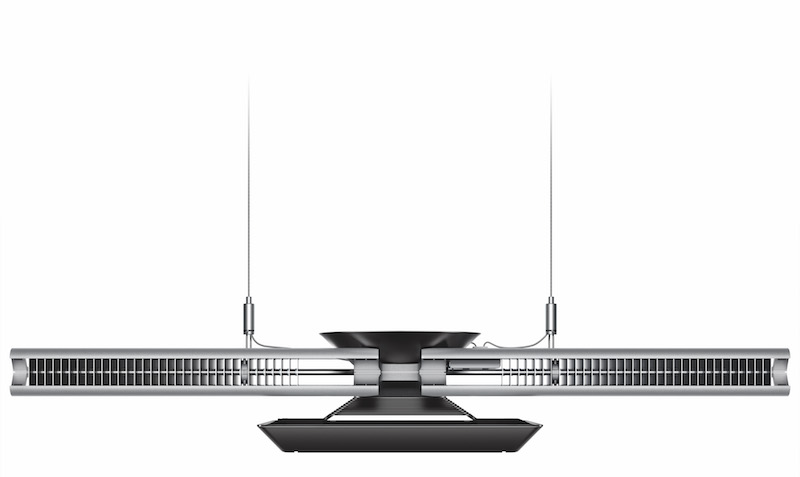Dyson is mostly known for its (expensive) vacuum cleaners that claim to never lose suction and have the ability to get every inch of your carpet clean, but Dyson’s newest invention isn’t a new super powerful or ultra quiet vacuum cleaner, in fact, it isn’t a vacuum cleaner at all; it’s the Cu-Beam Duo, a light that is rated to operate for 22 years without a bulb change.
As Fastcodesign.com reports, the Cu-Beam Duo is a new lighting system that uses just two LEDs, not the hundreds that most commercial lighting fixtures use, to light the space below the fixture, above the fixture, or a combination of the two. Each LED is about the size of a quarter, massive for LED standards, and is fitted with custom-engineered lenses to spread the glow over a larger area. One LED provides the light for task surfaces below while the other provides the ceiling light, which is optimal for illuminating open spaces like atriums, or offices.
The actual lights make up just a small portion of the 28-inch fixture, however. The rest is a large heat sink with the sole purpose of keeping the LEDs cool because a cool LED can run for a very long time without fading or discoloring. The Cu-Beam Duo uses heat pipe technology to cool the two LEDs.

The Cu-Beam Duo uses six vacuum-sealed heat pipes to transfer heat away from the light source to be dissipated along the wings. Each tube contains a drop of water. When the light is turned on, the heat turns the water into vapor. The vapor then disperses throughout the pipe and, when it reaches a cool area of the tube, condenses back into water. A copper wick then draws the water back toward the heat source and the process starts again.
The idea to cool LEDs with a heat pipe was first used in the CSYS desk lamp, a lamp that came with the promise of running for 40 or 50 years without needing to change the bulb. The Cu-Beam Duo takes this initial technology and improves and expands upon it.
The stock light puts out 8,500 lumens but it can be changed and fitted with a 20,000 lumen LED. Additionally, there are sensors that can detect when no one is at the table or workspace below and shut off the down light, leaving just the up beam on to keep the room illuminated. Additionally, the each lamp has internal shutters that can crop the down beam to the width of the table below with no spill. The crop light is not wasted, though. The Cu-Beam Duo uses "Ricochet" technology to convert any unwanted down light into up light.
The Cu-Beam Duo has not been priced yet, but the company says it was designed with the intention of being used for large-scale, commercial products. The lights will be available in silver, black, and white with Dyson offering a range of custom colors, as well.
Related Stories
Products and Materials | Sep 30, 2024
Top building products for September 2024
BD+C Editors break down September's top 15 building products, from the Crystal W50i to Armstrong's DesignStackz Ceiling System.
Lighting | Jun 10, 2024
LEDs were nearly half of the installed base of lighting products in the U.S. in 2020
Federal government research shows a huge leap in the penetration of LEDs in the lighting market from 2010 to 2020. In 2010 and 2015, LED installations represented 1% and 8% of overall lighting inventory, respectively.
ProConnect Events | Apr 23, 2024
5 more ProConnect events scheduled for 2024, including all-new 'AEC Giants'
SGC Horizon present 7 ProConnect events in 2024.
75 Top Building Products | Apr 22, 2024
Enter today! BD+C's 75 Top Building Products for 2024
BD+C editors are now accepting submissions for the annual 75 Top Building Products awards. The winners will be featured in the November/December 2024 issue of Building Design+Construction.
Adaptive Reuse | Mar 30, 2024
Hotel vs. office: Different challenges in commercial to residential conversions
In the midst of a national housing shortage, developers are examining the viability of commercial to residential conversions as a solution to both problems.
Lighting | Mar 4, 2024
Illuminating your path to energy efficiency
Design Collaborative's Kelsey Rowe, PE, CLD, shares some tools, resources, and next steps to guide you through the process of lighting design.
Sponsored | Performing Arts Centers | Jan 17, 2024
Performance-based facilities for performing arts boost the bottom line
A look at design trends for “budget-wise” performing arts facilities reveals ways in which well-planned and well-built facilities help performers and audiences get the most out of the arts. This continuing education course is worth 1.0 AIA learning unit.
75 Top Building Products | Dec 13, 2023
75 top building products for 2023
From a bladeless rooftop wind energy system, to a troffer light fixture with built-in continuous visible light disinfection, innovation is plentiful in Building Design+Construction's annual 75 Top Products report.
Healthcare Facilities | Oct 11, 2023
Leveraging land and light to enhance patient care
GBBN interior designer Kristin Greeley shares insights from the firm's latest project: a cancer center in Santa Fe, N.M.
Products and Materials | Jul 31, 2023
Top building products for July 2023
BD+C Editors break down 15 of the top building products this month, from cleanroom doors to window storm protection systems.

















